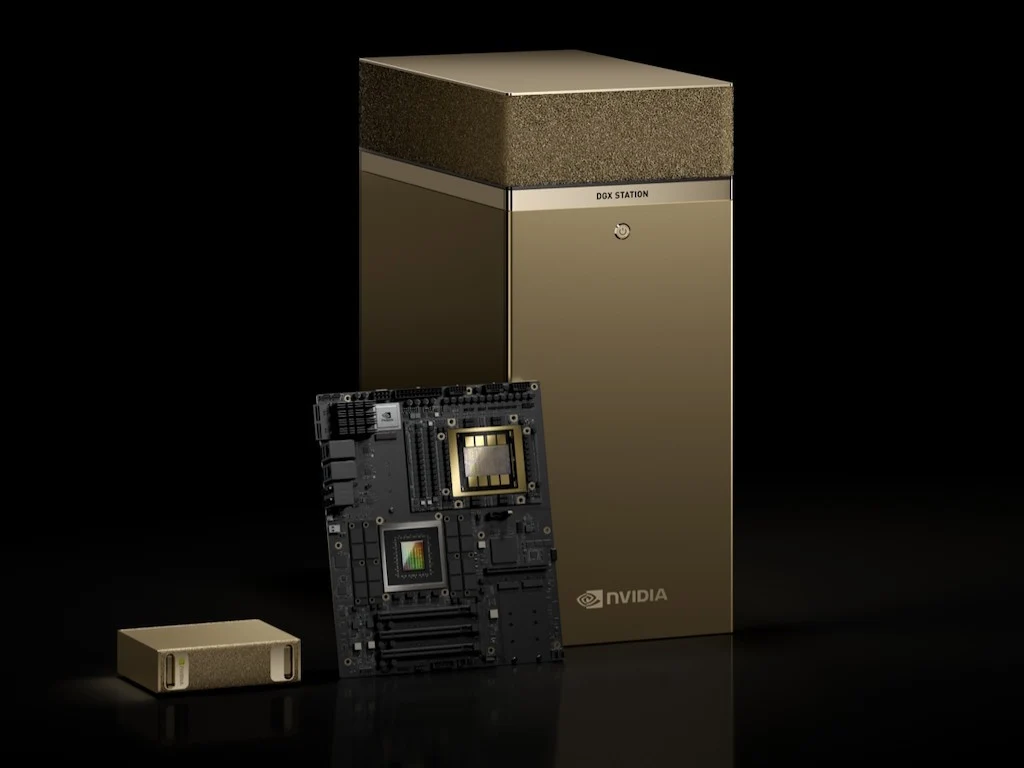Key Takeaways
1. Nvidia’s DGX Station is a powerful AI supercomputer designed for developers and researchers to build and run large language models (LLMs) locally.
2. The DGX Station features the GB300 Grace Blackwell Ultra Superchip, enabling it to handle models with up to 200 billion parameters and offering significant performance improvements over the smaller DGX Spark.
3. Its architecture includes a 72-core Grace CPU and Blackwell Ultra GPU, connected via NVLink-C2C, providing seven times the bandwidth of PCIe Gen 5 and enhancing AI processing efficiency.
4. The DGX Station utilizes the ConnectX-8 SuperNIC for fast networking and runs on a customized version of Ubuntu Linux, facilitating easy transition from local to cloud-based AI model deployment.
5. The DGX Station is expected to be available from third-party manufacturers in late 2025, while Nvidia’s 5090 GPU is currently available for those looking to develop AI LLMs now, albeit at high prices.
Nvidia has introduced its latest desktop AI supercomputer, known as the DGX Station. This advanced machine is tailored for AI developers, researchers, and data scientists, enabling them to build and execute their large language models (LLMs) and projects locally.
Enhanced Power and Performance
The DGX Station boasts significantly greater capabilities compared to the smaller DGX Spark (previously referred to as Project DIGITS), as it can handle local models with 200 billion parameters, thanks to the GB300 Grace Blackwell Ultra Desktop Superchip. This Superchip is equipped with 496GB LPDDR5X of CPU memory alongside 288GB HBM3e of GPU memory.
Cutting-Edge Architecture
Featuring a 72-core Grace CPU linked via NVLink-C2C to a Blackwell Ultra GPU, the Superchip’s NVLink-C2C connection offers seven times the bandwidth of PCIe Gen 5, reaching speeds of 900 GB/s. The Blackwell Ultra GPU is capable of delivering up to 1.5 times the AI FLOPS compared to the Blackwell GPU, and it is specifically optimized to process FP4 models. This enhancement boosts AI processing efficiency by alleviating memory and computational demands.
Networking and Operating System
The DGX Station connects with other DGX Stations using the ConnectX-8 SuperNIC, which can transfer data at speeds of up to 800 Gb/s. It operates on a customized version of Ubuntu Linux, known as the DGX operating system, which is tailored to support the complete Nvidia AI software stack. This setup facilitates the transition of LLM AI models from local development to the cloud, simplifying their release and scaling. The DGX Station is expected to be available from third-party computer manufacturers in late 2025.
For those eager to dive into AI LLM development right now, you can purchase an Nvidia 5090 GPU (available on Amazon) which can run models up to approximately 30 billion parameters. However, it’s important to note that the 5090 cards are currently priced well above their MSRP, exceeding $4,000. The 4060 Ti 16GB GPU, which can manage models up to around 14 billion parameters, is also overpriced but can be found for under $1,000 (also available on Amazon).
Nvidia has made this announcement through its news release, highlighting the arrival of both the DGX Spark and DGX Station personal AI computers. These systems, powered by NVIDIA Grace Blackwell, aim to bring accelerated AI capabilities to developers, researchers, and data scientists, with prominent computer manufacturers such as ASUS, Dell Technologies, HP, and Lenovo set to produce them.
Source:
Link


Leave a Reply